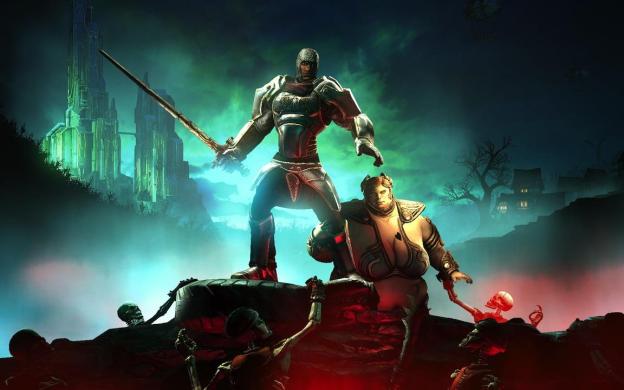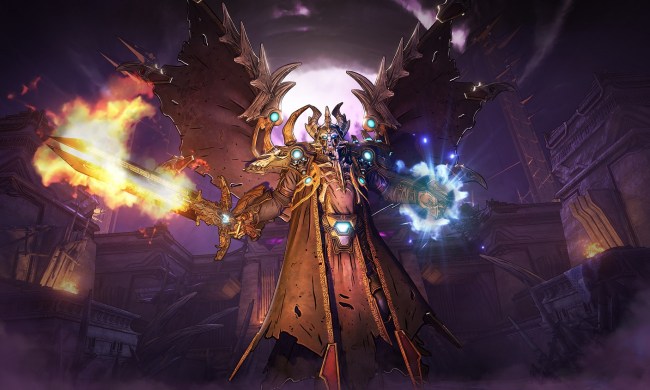
You’ve never seen anything quite like Tiny Tina’s Assault on Dragon Keep in Borderlands 2. The final helping of content in Gearbox Software’s DLC “season” goes completely off the rails, conceptually speaking, plunging players into a fantasy world constructed entirely by Pandora’s resident (and incredibly green) dungeon master, Tiny Tina.
The diminutive spitfire tones down her schtick a little bit from the main game as she becomes the driving storyteller for Dragon Keep, but the character’s infectious wit and … unique vernacular are very much intact. The DLC begins with our heroes sitting down for a game of Bunkers & Badasses, the tabletop RPG of choice for Pandora-dwellers.
The dev team always hoped to take things in a more fantastical direction, but the original plan for the DLC now known as Dragon Keep didn’t involve Tiny Tina at all. Her inclusion grew organically out of an initial concept with a much smaller scope, lead writer Anthony Burch tells us, but it quickly became clear that there was an opportunity to go bigger.

“[Creative director Paul Hellquist] and I were bullshitting one day, talking about how it might be funny if … you go to a Hyperion base or something like that and Handsome Jack’s nephew runs it like a D&D campaign,” Burch explains. “The idea wasn’t to actually do D&D stuff, but the concept of a character who is in complete, absolute control of one location, allowing us to do some really cool things. Having a narrative explanation for why somebody might rearrange an entire combat [scenario] just for the fuck of it.”
This idea carries forward into the Dragon Keep, with Tina’s words bringing about active changes in the world around you. Early on in the DLC you encounter a massive, uber-leveled dragon that decimates you with little more than a hard stare. As you expire and it quickly becomes clear that you are straight-up outmatched, Tina admits that she may be getting a little ahead of herself. She sets the scene for a second time, replacing the dragon with a much more manageable, pint-sized skeleton miniboss.

“Having one character be the god of a location gives you a lot of narrative freedom,” Burch continues. “It can keep the player on their toes, and impact gameplay and the actual world in front of the player rather than just having to deliver story through audio.”
Tina came into play when Burch and Hellquist looked at the pitch and rolled their ideas at sending players up against another gauntlet of tweaked Hyperion robots. The idea transformed over time and eventually took shape with Tina running a tabletop RPG that would send the Vault Hunters of Borderlands 2 through a completely fantastical set of environments that feature new scenery, new monsters, and slightly tweaked mechanics. This caused some worries initially, due to the amount of extra work involved, say the devs, but there was enough excitement about bringing pure fantasy to Pandora that the hesitation quickly became a non-issue.

“In DLCs, we try to recontextualize and reuse certain things, so we can do them much quicker. And we knew with this idea … we’d have to go all the way,” Hellquist says. “We knew if we committed to the idea of being transported to an imaginary fantasy world, we probably can’t just reuse our bandits and we probably can’t have a straight up skag. The skeletons aren’t bandits that have a skeleton model. That’s [new] models, all-new behaviors, archery, swords, shields … all that stuff is new stuff that we had to put together.”
The net result of this added work is the biggest Borderlands 2 DLC yet, and the most dramatically different take on the series’ looter-shooter play that we’ve seen. Hellquist and Burch proudly tout the fact that Dragon Keep features more new enemies than there were in all of the previous DLC releases combined. In fact, the count is roughly equal to the number of enemies in the vanilla game.

There’s also just a general focus on more. New ways of spending Eridium, including specialized slot machines, buff-inducing Shrines, and special D20 chests whose contents are determined when players roll a 20-side die perched on top. Spending a bit of Eridium gives you two dice to roll, with the higher result informing the quality of chest items. Then there are non-hostile Pixies that actively buff you (provided you don’t accidentally shoot/damage them) and, as mentioned, a vast assortment of new enemies: skeletons, dragons, armored knights, treants, and plenty more.
The new Circle of Slaughter “is all about magic and traps and shit like that, in this crazy temple.”
Then there’s the expected assortment of new gear, including a whole new set of class mods that bestow each character with new titles that nod heavily in the direction of Dungeons & Dragons. “You can become a Lawful Good Ranger if you’re a Commando. Things like that,” Hellquist says. “Each class has one that follows each of the alignments and turns their class name into something fantasy-themed. So the Commando is a Ranger and I think the Siren is a Sorceress [for example].”

Players can expect references to anything from Dark Souls to Game of Thrones to Sword in the Stone to (for some strange reason) Darkman. This is part of the fun of having a very inexperienced Tina at the center of the storytelling, as Hellquist describes it.
“Having Tiny Tina be the keeper of this imaginary world also allowed the sort of on-the-nose cliche stuff that we’re doing feel more in line because that’s what she knows,” he says. “She’s still a child and she’s new to running a dungeon and all that kind of stuff. So she’s falling back on the things that she knows that are are out there. It helps to bring it all together and not just bring it out of left field.”
Except for Darkman. That bit is totally out of left field. Awesome too.
“If Tina’s going to be the DM, she’s going to need to be pulled back a little bit from where she was in the main game.”
“My first draft was really, really, really too far back and she was just talking like a normal adult with not a lot of emotion. I showed it to Ash and she said, ‘I think you may have gone a little bit too far and lost some of the Tina stuff.’ That was just a matter of going back in and putting in words like humpadump and saying, ‘Oh, you don’t say this line, you sing it like a rap.'”
This next bit is a little bit spoiler-y for those who haven’t completed the main story in Borderlands 2. This is your warning.

The light tone that pervades your early hours in Dragon Keep belies the dev team’s overriding goal of using this final DLC of the season to cap off the hours players have spent in Borderlands 2. Tina references Roland and Bloodwing early on, two key characters that did not survive the events of the 2012 sequel’s main story. Burch makes it clear that this isn’t a situation in which she just fails to realize that they’re gone.
“What’s actually going on is, as the DLC progresses [it becomes clear] that Tina is using this Dungeons & Dragons module to cope with the fact that a lot of her friends are dead,” he says. “She uses it initially as a denial mechanism, and then, as it goes on, her walls of denial are going to begin crumbling and characters that she cared about or that influenced the main plot are going to start infecting the narrative.”
“You’ll see people like Roland, you’ll see Angel, you’ll see Jack, but her own mental versions of them. The way she looks at Roland, the way she looks at those characters. It actually ends at a point that feels very much like a closing kind of note. It’s a very personal note, nothing big and global.”
Hellquist adds, “There are the two stories: there’s the module that you adventure in and then there’s the story of the people playing the module at the table. We really wanted the people at the table to change by the end. That this experience of playing this game together has brought some change to all of their lives just in terms of where they are emotionally. I think it’s really ultimately a touching story when you get through it.”

